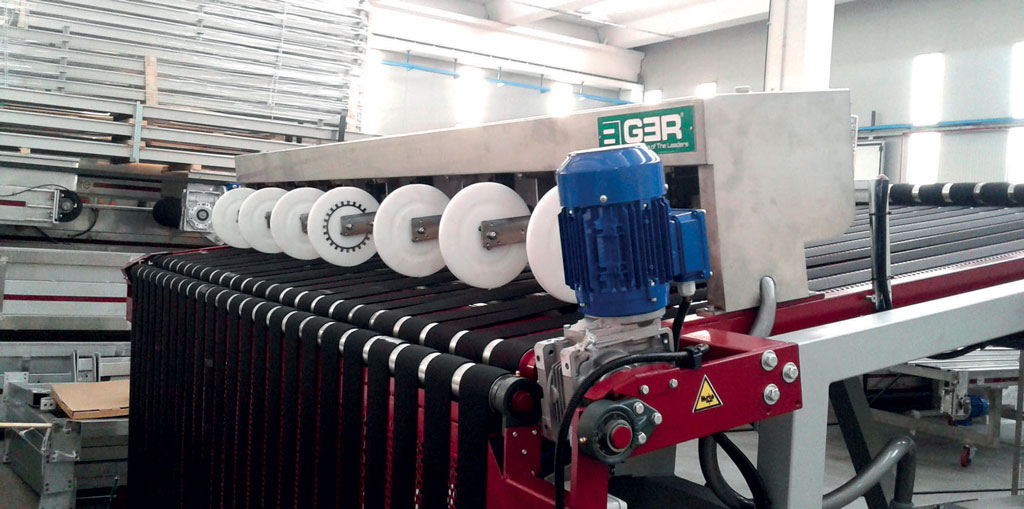
DIGITALISATION, BIG DATA, ARTIFICIAL INTELLIGENCE: THIS IS HOW THE “TANNERY OF THE FUTURE” CAME ABOUT
Today as never before, the industrial world is evolving quic-kly, meeting numerous challenges. They are changes that must be faced, and which find digitalisation to be the key in facing the transformations demanded by industry 4.0.
The need to implement systems that can stand up to diffe-rent challenges is a theme that GER, on the market for 45 years and the first to produce electronic surface measurers for finished leathers, has made its own from when it started doing business. Today, this jump into the future uses the potentiality of big data and artificial intelligence to actualise the ambitious “tannery of the future” project. All with a new way of interpreting measurement.

SHAVING
Measuring the thicknesses after shaving is a key piece of data that is just as important as quality control in real time. Comparing the production costs and value gives a real time estimate of the overall output of the batch up to mapping, and makes it possible to certify the thickness.
SETTING OUT/TOGGLING/STAKING/BUFFING/EMBOSSING/IRONING
Identifying each leather in a batch during the various processing phases and measuring the surface means that the times and output of each process can be quantified, identifying possible critical points and permitting process optimisation as a whole.


LIME SPLITTING
Mapping the thickness distribu-tion over the whole surface of each hide makes it possible to control splitting quality in real time and gives precise data for direc-ting each batch so as to obtain maximum output.
SAMMYING
The automated and continual collection of data such as choice, cut, thickness and weight does not just lead to precise classification, perfect for enhancing groups of hides with similar characteristics, but also the quantification in real time of each batch output.
WET SPLITTING
Mapping the thicknesses of each hides makes it possible to conti-nually control the process quality and automatically adjust the split-ter in real time, which maximises the value of the grains and redu- ces the production of waste at shaving.

A VIRTUOUS ECOSYSTEM
BE.PROCESS falls into this context. A new concept applied to tanning, its aim is to create a virtuous ecosystem which, through big data, can analyse and optimise the whole production process, with countless advantages. More specifically, BE.PROCESS is based on the use of sensors which, introduced during each process phase, analyse the various characteristics of each leather. Information on the surface, colour, thickness, softness and weight of the leather is turned into objective data which, in the traditional process, are reserved exclusively for the operators. This creates what GER calls “ tannery know how digitalisation”, namely the digital archiving of how every tannery processes its leather. System use increases the quality and repeatability of the finished product performance and, as a result, protects precious resources.
The volume of the data generated by the system requires modern technology to be analysed correctly, and this is why I.Data was developed. I.Data is a data analysis program that uses a “tannery friendly” interface to show what determines company production quality, phase by phase, lot after lot.

SPRAYING
A spray finish is one of the most delicate processes and an important cost centre in the tanning process. Numerous variables have to be monitored to control its cost- effectiveness, with immediate signalling if irregularities occur:
– no. of leathers and surfaces processed
– chemical product consumption
– energy consumption
– processing times
– gun operation management
– quality of the finishing product distribution, quality of the colours of each leather
– etc…


MEASURING
The final quality control involving measuring the surface characteristics, thickness, colour of each leather makes guaranteeing total respect of the requested standards, but also performance assessment processing, possible.
PACKING
Automating the packing process, in addition to re-allocating human resources to processes with a higher additional value, also makes centralised and continual control of stock that is being dispatched and, in the warehouse, possible, in addition to process completion with the final phase, an important thing when presenting the finished product to your clients.

CARING FOR THE ENVIRONMENT
The advantages of tanning processes that implement the BE.PROCESS system do not stop there, however: the environment also benefits, thanks to it. Reduced consumption, waste, and all the additional work done to “correct the pull” during the process phase make notable savings automatic, which in turn favours sustainable development. Pollution and resource consumption regulations, in the same way as those on the use of energy and chemical compounds, will always be stricter.
Sustainability in the tannery sector therefore becomes a challenge to transform the limits set by the market into something that is profitable for companies. An initial example involves the traceability that is required for ethical reasons; if correctly managed it becomes industrial traceability, which helps control the production process in an increasingly more precise manner.
